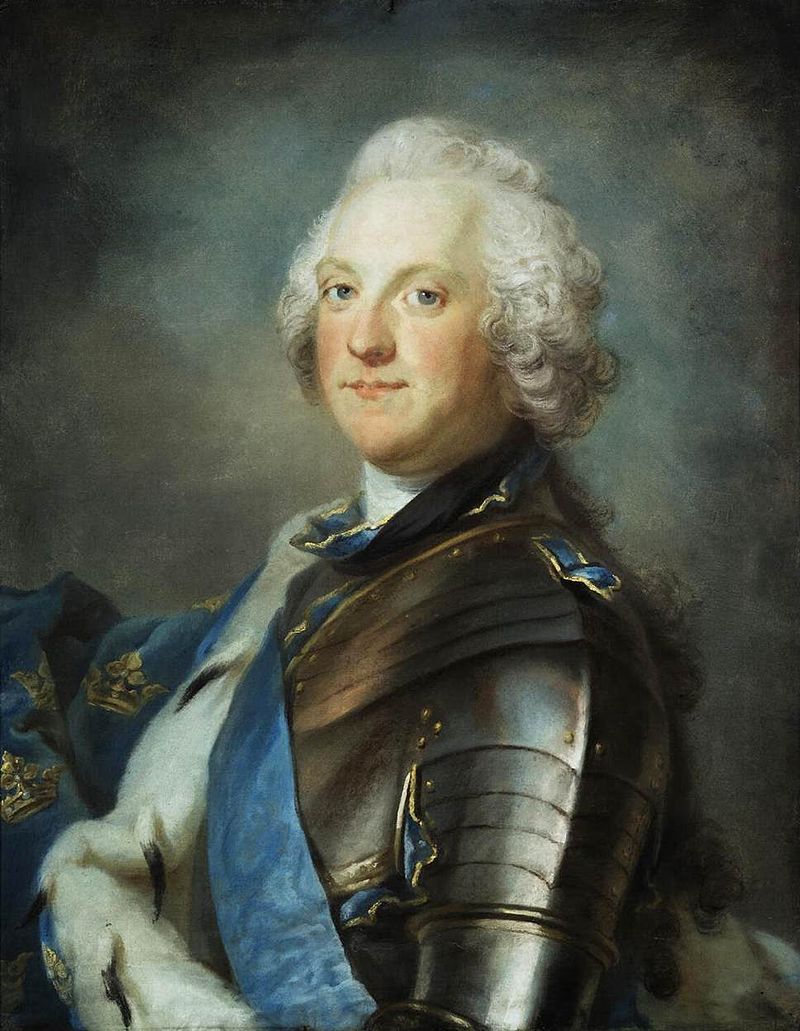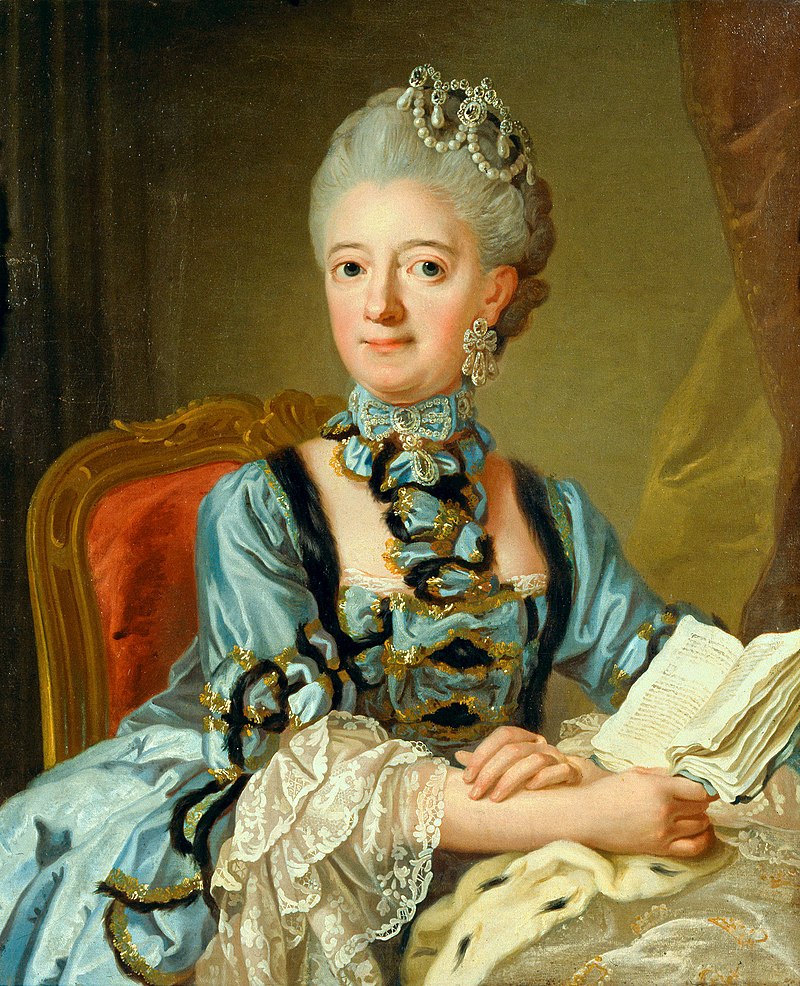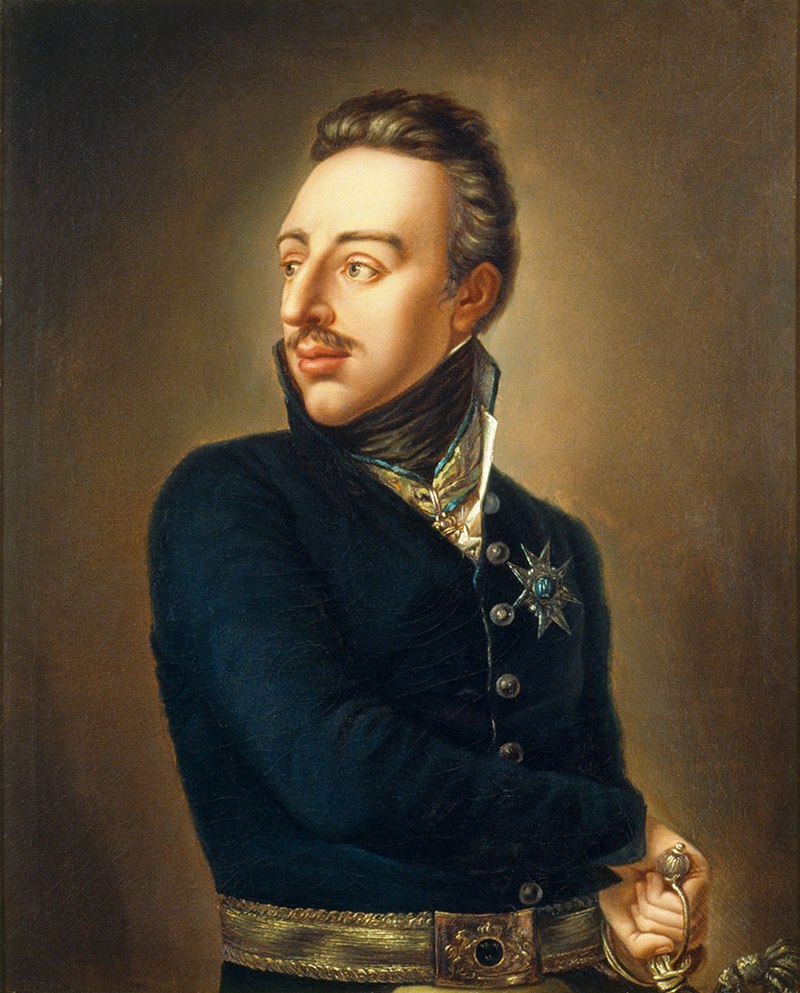by Susan Flantzer
© Unofficial Royalty 2021
In 1720, Ulrika Eleonora, Queen of Sweden, the last of the House of Palatinate-Zweibrücken, abdicated in favor of her husband who became Fredrik I, King of Sweden of the House of Hesse. The marriage of Ulrika Eleonora and Fredrik was childless and it fell to the Riksdag (the Swedish legislature) to elect Fredrik’s successor.
During the Russo-Swedish War of 1741 – 1743, Russia was the victor and Sweden lost territory to Russia. Russia was ruled by Elizabeth, Empress of All Russia who was unmarried. As her heir, Empress Elizabeth had named Karl Peter Ulrich of Holstein-Gottorp (the future Peter III, Emperor of All Russia), the 14-year-old son of her deceased elder sister Anna Petrovna of Russia and the deceased Karl Friedrich, Duke of Holstein-Gottorp, the first cousin of Adolf Friedrich of Holstein-Gottorp. The young Karl Peter Ulrich was the Duke of Holstein-Gottorp and Adolf Friedrich of Holstein-Gottorp was the administrator of the Duchy of Holstein-Gottorp during Karl Peter Ulrich’s minority
Negotiations were opened with Elizabeth, Empress of All Russia, who agreed to restore the greater part of Finland to Sweden if Adolf Friedrich of Holstein-Gottorp, was elected Crown Prince of Sweden. The Riksdag accepted the terms of Empress Elizabeth and upon the death of Fredrik I, King of Sweden in 1751, Adolf Friedrich of Holstein-Gottorp became Adolf Frederik, King of Sweden.
All photos are from Wikipedia unless otherwise noted.
*********************
Riddarholmen Church
Riddarholmen Church is Stockholm’s oldest preserved building. It was originally built as a part of a Roman Catholic monastery in the late 13th century and is Stockholm’s only preserved medieval monastery church. During the Reformation, it was transformed into a Protestant church. Now it is used only as a burial place and a place for commemorative services.
From the time of the funeral of King Gustav II Adolf (Gustavus Adolphus the Great) in 1634, Riddarholmen Church served as the royal burial church. Swedish monarchs from King Gustav II Adolf (died 1632, interred 1634) to King Gustaf V (died 1950) were buried at Riddarholmen Church except for Queen Christina who abdicated, converted to Roman Catholicism, and was buried at St. Peter’s Basilica in Rome.
- Unofficial Royalty: Riddarholmen Church in Stockholm, Sweden
- Swedish Royal Court: Riddarholmen Church
*********************
House of Holstein-Gottorp
- King Adolf Fredrik of Sweden (reigned 1751 – 1771)
- King Gustav III of Sweden (reigned 1771 – 1792, assassinated)
- King Gustav IV Adolf of Sweden (reigned 1792 – 1809, abdicated)
- King Carl XIII of Sweden (reigned 1809 – 1818) also King Karl II of Norway (reigned 1814 – 1818)
*********************
Adolf Frederik, King of Sweden (reigned March 25, 1751 – February 12, 1771)

Adolf Friedrich of Holstein-Gottorp was born on May 14, 1710 at Gottorp Castle in the Duchy of Holstein-Gottorp, now in the German state of Schleswig-Holstein. He was the son of Christian August of Holstein-Gottorp, Prince of Eutin and Albertina Frederica of Baden-Durlach. After his first cousin, Karl Friedrich, Duke of Holstein-Gottorp, died in 1739, Adolf Friedrich became the administrator of the Duchy of Holstein-Gottorp during the minority of the deceased duke’s underage son Karl Peter Ulrich. As explained above, Karl Peter Ulrich became the heir of his aunt Elizabeth, Empress of All Russia and through the machinations of Empress Elizabeth, Adolf Friedrich became heir to the throne of Sweden and succeeded to the throne in 1751 as Adolf Frederik, King of Sweden.
Adolf Frederik married Louisa Ulrika of Prussia and the couple had four children including Adolf Frederik’s successor Gustav III, King of Sweden. At the age of 60, Adolf Frederik died on February 12, 1771, at the Royal Palace in Stockholm, Sweden after eating an extremely large meal and then suffering a stroke. In Sweden, he is remembered as “the king who ate himself to death.” He was buried at Riddarholmen Church in Stockholm, Sweden.

Tomb of King Adolf Frederik; Photo Credit – www.findagrave.com
Louisa Ulrika of Prussia, Queen of Sweden

Louise Ulrika of Prussia was born in Berlin, Kingdom of Prussia, now in the German state of Brandenburg, on July 24, 1720. Her parents were Friedrich Wilhelm I, King of Prussia and Sophia Dorothea of Hanover, the daughter of King George I of Great Britain. On August 29, 1744, Louise Ukrika married Crown Prince Adolf Frederik of Sweden, born Adolf Friedrich of Holstein-Gottorp. Louise Ulrika gave birth to four children including two kings of Sweden. Due to issues Louise Ulrika had with her elder son King Gustav III, she was banned from the court and spent the remainder of her life at other palaces.
In the spring of 1782, Louisa Ulrika became ill during an influenza epidemic. After mediation by her daughter-in-law Hedwig Elizabeth Charlotte (wife of her son Carl), Louisa Ulrika and her son King Gustav III finally reconciled. She then requested that Sofia Magdalena and four-year-old Crown Prince Gustav Adolf, whom she had never met, come to her room. Louisa Ulrika died at the age of 61 on July 16, 1782, at Svartsjö Palace with her son Frederik Adolf, her daughter Sophia Albertine, and her daughter-in-law Hedwig Elizabeth Charlotte present. She was buried at Riddarholm Church in Stockholm, Sweden.

Tomb of Louisa Ulrika; Credit – www.findagrave.com
*********************
Gustav III, King of Sweden (reigned February 12, 1771 – March 29, 1792, assassinated)

- Unofficial Royalty: Gustav III, King of Sweden
- Unofficial Royalty: Assassination of Gustav III, King of Sweden
Gustav III, King of Sweden was born on January 24, 1746, at the Wrangel Palace on Riddarholmen islet in Gamla Stan, the old town of Stockholm, Sweden, the son of King Adolf Fredrik of Sweden and Louisa Ulrika of Prussia. Gustav III married Sophia Magdalena of Denmark. They had two sons but only one survived childhood and went on to succeed his father.
King Gustav III of Sweden is best known for being mortally wounded during a masked ball at the Royal Opera House in Stockholm, Sweden, and dying thirteen days later, on March 29, 1792, from pneumonia and blood poisoning at the Royal Palace of Stockholm at the age of 46. The incident was the subject of Giuseppe Verdi’s 1859 opera Un Ballo in Maschera (A Masked Ball). King Gustav III was given a magnificent funeral at Riddarholmen Church in Stockholm, Sweden where he was also buried.

Tomb of King Gustav III; Photo Credit – www.findagrave.com
Sophia Magdalena of Denmark, Queen of Sweden

Sophia Magdalena of Denmark was born on July 3, 1746, at Christiansborg Palace in Copenhagen, Denmark, She was the eldest daughter and the eldest surviving child of the four children of King Frederik V of Denmark and Norway and his first wife Princess Louisa of Great Britain, a daughter of King George II of Great Britain. On November 4, 1766, at the Royal Chapel at the Royal Palace of Stockholm, Sweden, Sophia Magdalena married the future Gustav III, King of Sweden and the couple had two children.
Sophia Magdalena was horrified by the assassination of her husband, but it was a relief that as Queen Dowager, she could retreat from public life. She lived in the Royal Palace in Stockholm during the winter, and at Ulriksdal Palace during the summer. Sophia Magdalena died from a stroke at the age of 67 on August 21, 1813, at Ulriksdal Palace. She was buried at Riddarholm Church in Stockholm, Sweden.

Tomb of Sophia Magdalena; Credit – www.findagrave.com
*********************
Gustav IV Adolf, King of Sweden (reigned March 29, 1792 – March 29, 1809, abdicated)

King Gustav IV Adolf became king at the age of 13 when his father was assassinated and was deposed 17 years later in a coup. He was born at the Royal Palace of Stockholm on November 1, 1778, the elder of the two sons of King Gustav III of Sweden and Sophia Magdalena of Denmark. Gustav IV Adolf married Frederica of Baden and they had five children.
Provoked by the loss of Finland to Russia a group of noblemen started a coup d’état that deposed King Gustav IV Adolf. Gustav Adolf abdicated on March 29, 1809, thinking if he did so, his son would become king. However, the Riksdag proclaimed that all members of Gustav IV Adolf’s family had forfeited their rights to the throne. His uncle Prince Karl was proclaimed King Karl XIII of Sweden and Gustav Adolf and his family were sent into exile and settled in the Grand Duchy of Baden, the homeland of his wife Frederica. However, the couple became incompatible and divorced in 1812. Gustav Adolf settled in a small hotel in St. Gallen, Switzerland where he lived in great loneliness.
On February 7, 1837, Gustav Adolf suffered a stroke and died at the age of 58. He was originally buried at Eichhorn Castle in Moravia (now in the Czech Republic) where his son, the Austrian Lieutenant Field Marshal Gustav, Prince of Vasa lived. In 1881, Gustav IV Adolf’s great-granddaughter Victoria of Baden married Crown Prince Gustaf of Sweden, the future King Gustaf V. At the suggestion of the Crown Prince’s father King Oscar II of Sweden, Gustav IV Adolf’s body was returned to Sweden and interred in the Riddarholmen Church.

Tomb of King Gustav IV Adolf; Photo Credit – www.findagrave.com
Frederica of Baden, Queen of Sweden

Frederica of Baden, was born on March 12, 1781, at Karlsruhe Palace in Karlsruhe, Duchy of Baden, now in the German state of Baden-Württemberg. She was the daughter of Karl Ludwig, Hereditary Prince of Baden and Amalie of Hesse-Darmstadt. Her father predeceased his father so he never became Grand Duke of Baden. On October 31, 1797, in the Royal Chapel at the Royal Palace of Stockholm, Frederica married Gustav IV Adolf, King of Sweden and they had five children.
After her husband was deposed, the family settled in Frederica’s home country, the Grand Duchy of Baden. However, Frederica and Gustav Adolf became incompatible and divorced in 1812. After her divorce, Frederica settled in Bruchsal Castle in Baden. She acquired several other residences in Baden and a country villa, Villamont, near Lausanne, Switzerland. Frederica spent most of her time at her brother’s court in Karlsruhe, but she also traveled around Germany, Switzerland, and Italy.
During her final years, Frederica was often ill. She died in Lausanne, Switzerland of heart disease on September 25, 1826, at the age of only 45. Frederica was buried at her family’s burial site, Schlosskirche St. Michael in Pforzheim, then in the Duchy of Baden, now in Baden-Württemberg, Germany.

Schlosskirche St. Michael; Photo Credit – Wikipedia
*********************
King Carl XIII of Sweden (reigned June 6, 1809 – February 5, 1818, also King Karl II of Norway, reigned November 4, 1814 – February 5, 1818)

Born the second son of King Adolf Frederik of Sweden and Louisa Ulrika of Prussia, Carl was not destined to be king, but at the age of 60, he became King of Sweden and reigned for nine years. He would be the last Swedish monarch of the House of Holstein-Gottorp. Prince Carl of Sweden was born on October 7, 1748, at the Wrangel Palace on Riddarholmen islet in Gamla Stan, the old town of Stockholm, Sweden. On July 7, 1774, Carl married his 15-year-old first cousin Hedwig Elisabeth Charlotte of Holstein-Gottorp. Carl and Hedwig Elisabeth Charlotte eventually had two children – one stillborn and one who lived only six days.
Upon the forced abdication of his nephew Gustav IV Adolf, King of Sweden, all of King Gustav IV Adolf’s descendants had been declared ineligible to succeed to the Swedish throne and Prince Carl was proclaimed King Carl XIII of Sweden. Carl was 60 years old and not in good health. In November 1809, he had a stroke and the Riksdag needed to find an heir to the throne. Prince Carl August of Schleswig-Holstein-Sonderburg-Augustenburg was chosen, however, he died from a stroke four months after arriving in Sweden. The Riksdag then elected the well-liked Jean Baptiste Bernadotte, one of Napoleon’s Marshals of France, as Crown Prince. He arrived in Stockholm in November 1810 and was formally adopted by King Carl XIII, taking the name Carl Johan, and converted from Roman Catholicism to Lutheranism.
King Carl XIII died on February 5, 1818, at the Royal Palace of Stockholm at the age of 69 and he was buried at Riddarholmen Church in Stockholm. Jean Baptiste Bernadotte ascended the throne. Thus began the Bernadotte dynasty in Sweden, which continues today.

Tomb of King Carl XIII of Sweden; Photo Credit – www.findagrave.com
Hedwig Elisabeth Charlotte of Holstein-Gottorp, Queen of Sweden

Hedwig Elisabeth Charlotte of Holstein-Gottorp was born on March 22, 1759, in Eutin, Duchy of Oldenburg, now in the German state of Schleswig-Holstein. Her parents were Friedrich August I, Duke of Oldenburg and Princess Ulrike Friederike Wilhelmine of Hesse-Kassel. She was a niece of King Adolf Fredrik of Sweden, the father of her future husband. On July 7, 1774, at the Royal Palace of Stockholm, Hedwig Elisabeth Charlotte married the future King Carl XIII of Sweden. The couple had no surviving children.
Hedwig Elisabeth Charlotte’s husband 60-year-old Carl became King of Sweden when his nephew Gustav IV Adolf, King of Sweden was deposed. Hedwig Elisabeth Charlotte’s health had begun to worsen in 1815. After her husband’s death on February 5, 1818, she said she would not be able to survive without him. On June 20, 1818, after a private dinner with the new King Carl XIV Johan, Hedwig Elisabeth Charlotte went to her room to write, fainted, and died at the age of 59. She was buried at Riddarholmen Church in Stockholm.

Tomb of Hedwig Elisabeth Charlotte; Photo Credit – www.finagrave.com
*********************
This article is the intellectual property of Unofficial Royalty and is NOT TO BE COPIED, EDITED, OR POSTED IN ANY FORM ON ANOTHER WEBSITE under any circumstances. It is permissible to use a link that directs to Unofficial Royalty.


